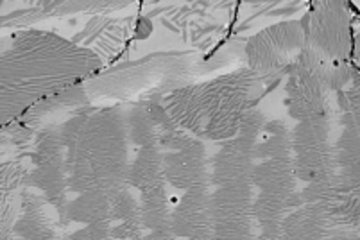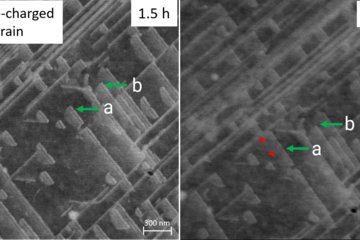All genres
1981.
Talk
A Constitutive Model for Glassy Polymers with Shear Transformation Zones Plasticity and Reptation-Based Viscoelasticity. MMM Third International Conference Multiscale Materials Modeling, Freiburg, Germany (2006)
1982.
Talk
A Study of Deformation and texture Evolution during Nanoindentation in a Cu Single Crystal using Phenomenological and Physically-Based Crystal Plasticity FE Models. MMM Third International Conference Multiscale Materials Modeling, Freiburg, Germany (2006)
1983.
Talk
Relative Importance of Nucleation vs. Growth for Recrystallisation of Particle-containing Fe3Al Alloys. Fundamentals of Deformation and Annealing Symposium, Manchester, UK (2006)
1984.
Talk
Recent Progress in the 3D Experimentation and Simulation of Nanoindents. Symposium Fundamentals of Deformation and Annealing, Manchester, UK (2006)
1985.
Talk
A Slip Interaction Based Measure of Damage Nucleation in Grain Boundaries. 3rd International Conference on Multiscale Materials Modeling, Freiburg, Germany (2006)
1986.
Talk
Neues aus der Eisenzeit - Simulationen und Experimente in der Kristallmechanik und frischer Hummer. Kolloquium an der Bundesantalt für Materialforschung (BAM), Berlin, Germany (2006)
1987.
Talk
Konstitutionsuntersuchungen im System Nb-Cr-Al: Erste Ergebnisse und weitere Planungen. Workshop: The Nature of Laves Phases VII, MPI für Metallforschung Stuttgart, Germany (2006)
1988.
Talk
Spherical indentation modeling for the investigation of primary recrystallization in a single-crystal nickel-base superalloy. Plasticity, Halifax, Canada (2006)
1989.
Talk
Slip Interactions Leading to Damage Nucleation in Grain Boundaries. Plasticity Conference 2006, Halifax, Canada (2006)
1990.
Talk
3D EBSD characterization and crystal plasticity FE simulation of the texture and microstructure below a nanoindent in Cu. Plasticity Conference 2006, Halifax, Canada (2006)
1991.
Talk
Orientation Microscopy on Nanostructured Electrodeposited CoNi Films. Thermec - 2006, Vancouver, Canada (2006)
1992.
Talk
Micomechanical Modeling of large plastic deformation in semi-crystalline polymers. Plasticity, Halifax, Canada (2006)
1993.
Talk
Mechanism-oriented steel development. New Methods of Steel Design, Aachen, Germany (2006)
1994.
Talk
3D-Orientierungsmikroskopie mittels FIB-SEM: Eine neue Dimension der Materialcharakterisierung. DGM, 5. AK-Treffen - Mikrostrukturcharakterisierung im REM, Halle, Germany (2006)
1995.
Talk
Recent Advances in Crystal Mechanics and Chitin Composites. Physics Colloquium at the Physics Department of the Technical University Dresden, Dresden, Germany (2006)
1996.
Talk
Crystal Mechanics and Fresh Lobster. Gordon laboratory, Invited Kolloquium Lecture, University of Cambridge, Cambridge, UK (2006)
1997.
Talk
Chaotic flows in microchannels: A lattice Boltzmann study. NSTI Nanotech 2006 Conference, Boston, MA, USA (2006)
1998.
Talk
Strain localization and microstructure evolution during plastic deformation of fiber reinforced polymer composites investigated by digital image correlation. Department Seminar, MPIE, Düsseldorf (Germany) (2006)
1999.
Talk
Orientation microscopy on electrodeposited samples. 13th Conference and Workshop on Electron Backscatter Diffraction, Oxford, UK (2006)
2000.
Talk
Advances in Constitutive Modeling in Crystal Plasticity FEM. Colloquium Lecture at the Department for Aeronautics at the Massachusetts Institute of Technology, Cambridge, USA (2006)











